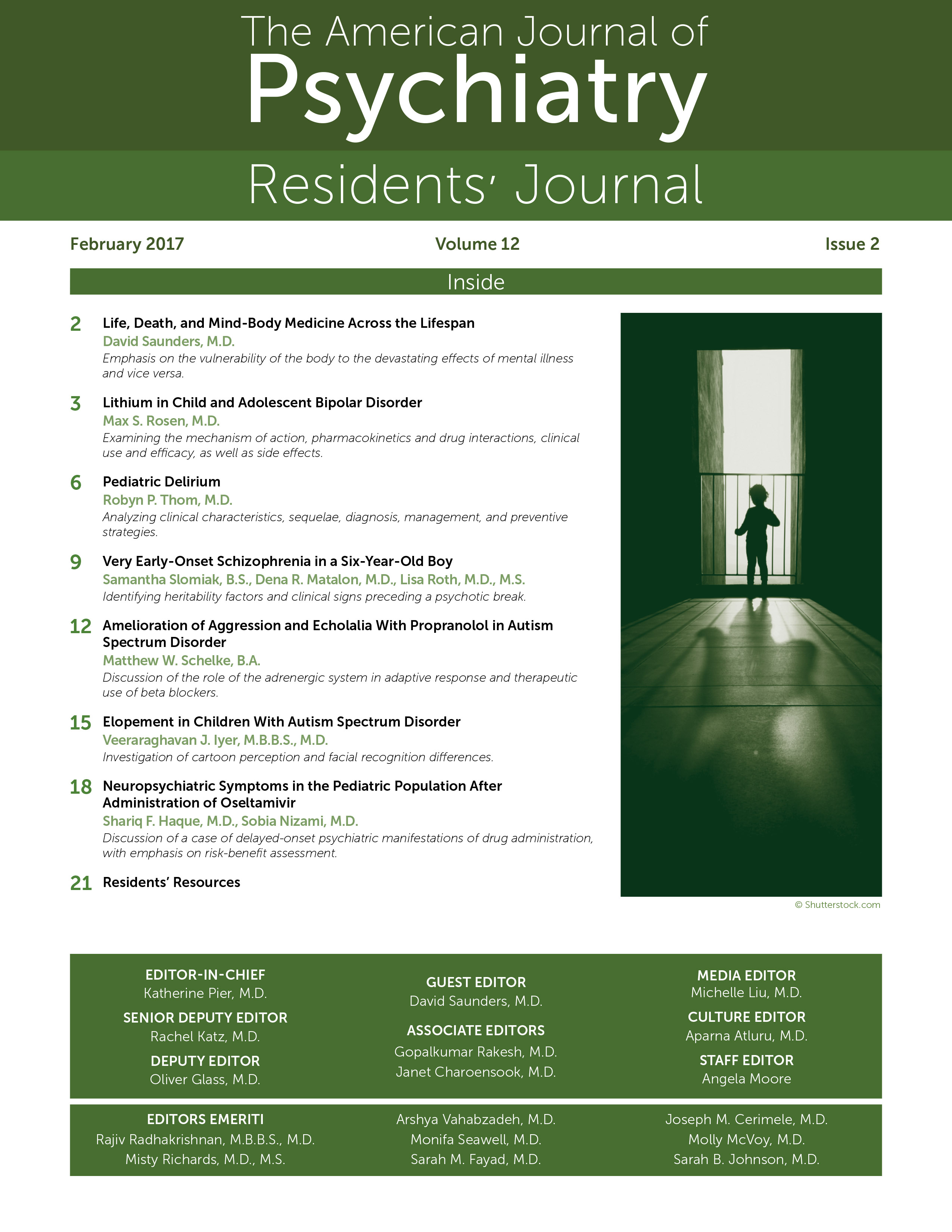Oseltamivir is a neuraminidase inhibitor used to treat influenza infection, which acts by inhibiting the release of replicated virus from infected cells. While shown to cause symptom relief in adults if taken within 48 hours of symptom onset, its use has shown no significant reduction in hospitalization rates or complications from infection in hospitalized patients (
1). Despite demonstration of limited benefit, the drug is widely used, with a total of 48 million patients receiving prescriptions for oseltamivir worldwide since 2006 (
1). Approximately 10% of the drug penetrates the blood-brain barrier (
1), which allows for potential neuropsychiatric side effects (
2). Neuropsychiatric sequelae of oseltamivir have been well documented in the medical literature (
3). The Food and Drug Administration added a warning about oseltamivir use and neuropsychiatric adverse events. The majority of these adverse events have been observed to have occurred in the pediatric population. Neuropsychiatric adverse events include delirium, disturbances in consciousness, perceptual changes, delusions, tremors, anxiety symptoms, seizure disorders, parasomnias, and apocrine and eccrine gland disorders (
4). Neuropsychiatric adverse events are delineated into sudden onset, which starts within 24 hours after administration, and delayed onset, which begins after 24 hours. Sudden-onset adverse events include sensory changes, impairments in cognition, and abnormal behaviors, whereas delayed-onset events mostly consist of abnormal behaviors (
2). Japan contraindicated its use among individuals aged 10 to 19 due to concerns of abnormal behaviors (
1). We describe a case of delayed-onset psychiatric manifestations of oseltamivir administration in and 8-year-old girl.
Case
“Sally” is an 8-year-old girl who presented to the emergency department with the complaint of auditory hallucinations for the past 2 weeks. Prior to the onset of auditory hallucinations, the patient was started on and completed a course of oral oseltamivir (60 mg b.i.d. for 5 days). She had tested positive for influenza A 2 weeks prior to using the rapid screen. After finishing the course of oseltamivir, she began endorsing auditory hallucinations. She described two voices, one sounding like her mother's, the other a male's voice. She further described the voices as, “In my head, yelling and screaming.”
The patient was born by caesarean section at 39 weeks gestation. She had normal milestones and no reported history of trauma or neglect. She was in regular schooling, with only recent reports from teachers of the patient endorsing auditory hallucinations. She had neither a past psychiatric history nor any family history of psychiatric conditions. Mental status examination revealed a typically developing 8-year-old female. No visual hallucinations were described; there were no mood symptoms; no delusions were elicited; and the patient did not complain of any anxiety. Her affect was moderately constricted, and her thought process was logical, with some thought blocking. The child did at times appear to be internally preoccupied. Complete blood count, metabolic profile, MRI scan, and continuous video EEG were unremarkable. Approximately 48 hours after admission, the patient stopped endorsing any auditory hallucinations, and she was subsequently discharged with outpatient follow-up. She did not receive any psychotropic medications and denied any psychiatric symptoms on outpatient follow-up.
Discussion
This above case describes delayed-onset psychiatric manifestations of oseltamivir administration in the pediatric population, as the hallucinations appeared after the completion of the course of oseltamivir. Oseltamivir appears to have a net excitatory effect in the CNS (
5). This is possibly attributed to sialylation (addition of sialic acid groups) of serum glycolipids, which in turn stimulates D2 receptors (
2,
6). Sialylation of serum glycolipids causes an increase of D2 receptor activity (dopamine neurons possess glycoside receptors that are activated in the presence of sialylated glycolipids) (
6), which has been associated with enhanced behaviors in mice (
6). In one study, mice exposed to either dopamine agonists or oseltamivir were more likely to jump down from a 20-cm high platform (
6). Hiasa et al. (
7) reported that if oseltamivir was administered to the intraventricular system in mice, this significantly increased spontaneous behavior, such as sniffing, jumping, rearing, turning, and walking. Another possible mechanism, postulated by Morimoto et al. (
8), implicated limbic GABAergic dysfunction. The authors reported a case of a 15-year-old patient with acute-onset neuropsychiatric effects after oseltamivir administration, which responded well to diazepam and midazolam (
8). The researchers report reduced GABA-A activity in the patient's right medial temporal lobe on SPECT scan. The clinical picture resembled autoimmune limbic encephalitis in the absence of abnormal CSF or EEG findings. Susceptibility of the pediatric population to these effects could be attributed to lower amounts of P-glycoprotein, which is present in the blood-brain barrier and is known to limit oseltamivir uptake (
9).
